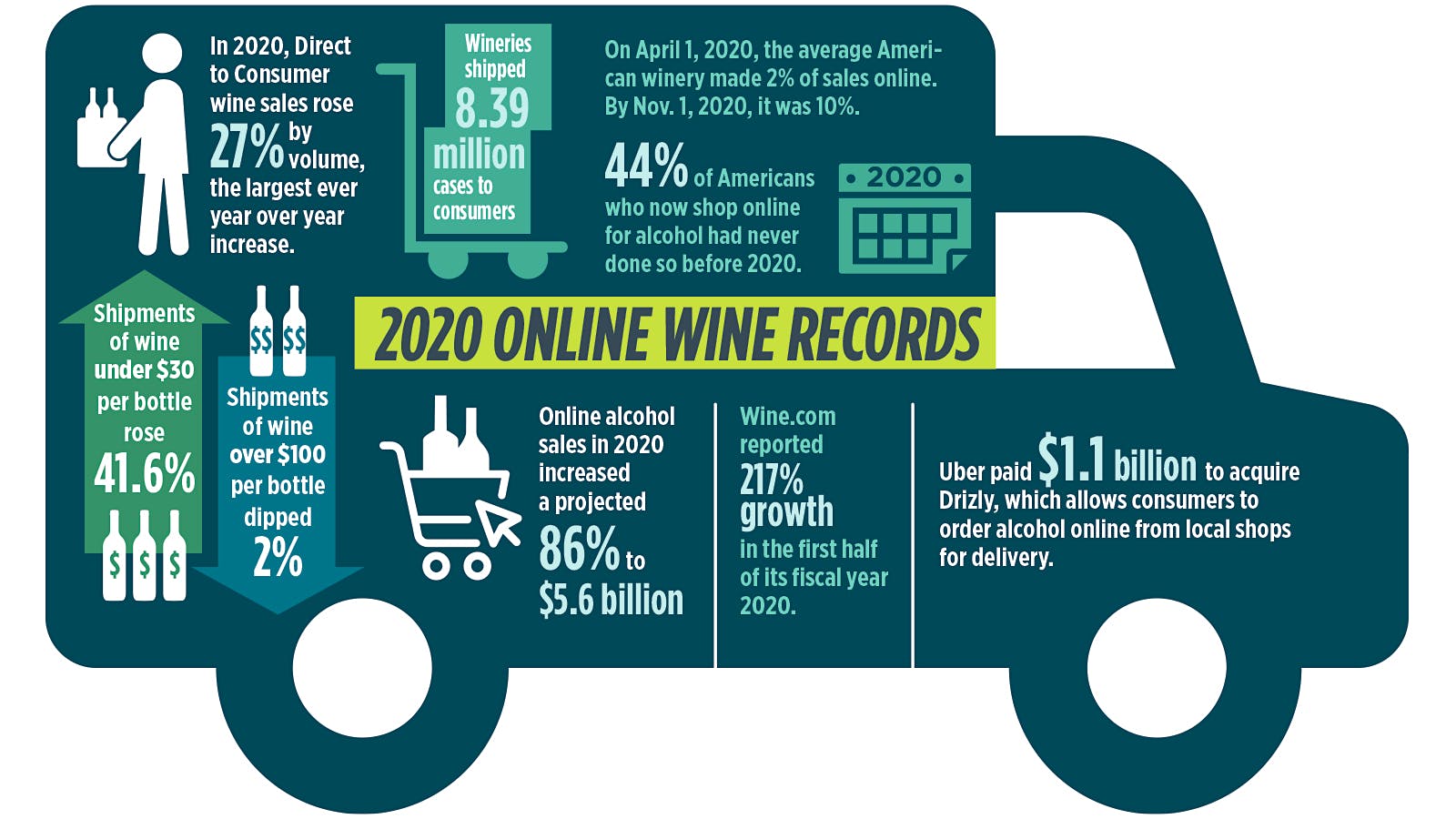“I’ve been urging wineries to up their online game since 2000,” says industry analyst Rob McMillan, executive vice president of Silicon Valley Bank’s wine division. “It took a pandemic to make it happen.”
By now, you have undoubtedly heard how the shutdowns that COVID-19 triggered across the nation last year upended the wine market. Restaurants and tasting rooms closed for significant parts of the year, and wineries had to adapt quickly or face financial ruin.
They adapted beautifully. Market analysts had predicted that wine would be stagnant before the pandemic began and expected the worst once businesses started shutting down. Instead, the numbers show that sales increased in both volume and value. Wineries showed incredible creativity in finding ways to reach consumers. An industry that had remained stubbornly old-school shifted to digital sales in a big way.
The big question for 2021 is, will it last?
When the shutdowns began, the old way of selling wine went out the window. The primary sales channels for many small wineries were restaurants and tasting rooms. Both were suddenly closed. While direct-to-consumer (DtC) sales from wineries have risen dramatically since a 2005 Supreme Court decision opened most states to direct shipping, the majority of online sales were rooted in the tasting room; consumers visited the winery, liked what they tried, and joined the wine club.
“E-commerce has been kind of an afterthought to most wineries,” says Paul Mabray, CEO at Pix and a digital sales specialist. “Why do it? Sales have been increasing every year as people spend more in the tasting room.” But with that model out the window, wineries had to reach out to consumers by phone, email and new tactics like virtual tastings. Zoom became the new tasting room. And it worked. According to industry analyst Sovos ShipCompliant, wineries shipped more than 8.39 million cases of wine in 2020, a 27 percent increase on 2019. Consumers, stuck at home and not spending money on dining out or taking trips, were eager to stock their bars.
What’s more, the kinds of consumers buying wine online broadened. International market analysis firm IWSR found that 44 percent of Americans who shopped online for alcohol in 2020 had never done so before. Most past DtC customers had been wine devotees, ordering wine they couldn’t find in the local shop. Now, casual wine drinkers were buying too. According to ShipCompliant, sales of wines priced over $100 per bottle decreased 2 percent, while sales of wines under $30 a bottle rose 41.6 percent.
But will this trend in winery DtC last?
Most economists now project that as more people get vaccinated, restrictions will ease and dining and tasting room sales will recover, possibly quickly as people celebrate the end of shutdowns. The market provided a preview of this in early fall of last year; when infection rates dipped and restrictions eased temporarily, online wine sales ebbed.
And wineries have plenty of competition. Online retailers also prospered during lockdown. The biggest, Wine.com, saw sales grow 217 percent in the first six months of the year and 119% for the entire year. As consumers increasingly found it easy and attractive to order alcohol online, Uber shelled out $1.1 billion at year’s end to buy Drizly, an app that facilitates online alcohol sales and delivery from local shops.
Wine industry analysts say wineries will need to build on what they learned during lockdowns. “A lot of winery DtC has been passive,” says Mabray. Consumers went to winery websites looking for their favorites. “Very few wineries have pursued active sales—finding new customers.” What’s more, most wineries haven’t been gathering data on who is buying online and what they’re looking for. McMillan found that 48 percent of U.S. wineries have no one on staff analyzing online sales.
Wineries do have a head start over most wine retailers. Direct shipping by out-of-state wineries is now legal in all but a handful of states. Direct shipping by out-of-state wine retailers is prohibited in 34 states. But that won’t last. Wineries have an advantage because they often engender strong customer loyalty, but they need to find consumers first. “Seize the moment,” says Jeff Carroll, general manager at Avalara, which helps wineries with DtC logistics. “You have big players getting involved.”
2020 Online Wine Records
In 2020, Direct to Consumer wine sales rose 27 percent by volume, the largest ever year over year increase.
Shipments of wine under $30 per bottle rose 41.6 percent.
Shipments of wine over $100 per bottle dipped 2 percent.
Wineries shipped 8.39 million cases to consumers.
On April 1, 2020, the average American winery made 2 percent of sales online. By Nov. 1, 2020, it was 10 percent.
44 percent of Americans who now shop online for alcohol had never done so before 2020.
Online alcohol sales in 2020 increased a projected 86 percent to $5.6 billion.
Wine.com reported 217 percent growth in the first half of its fiscal year 2020.
Uber paid $1.1 billion to acquire Drizly, which allows consumers to order alcohol online from local shops for delivery.
Sources: IWSR, Silicon Valley Bank, Sovos ShipCompliant
